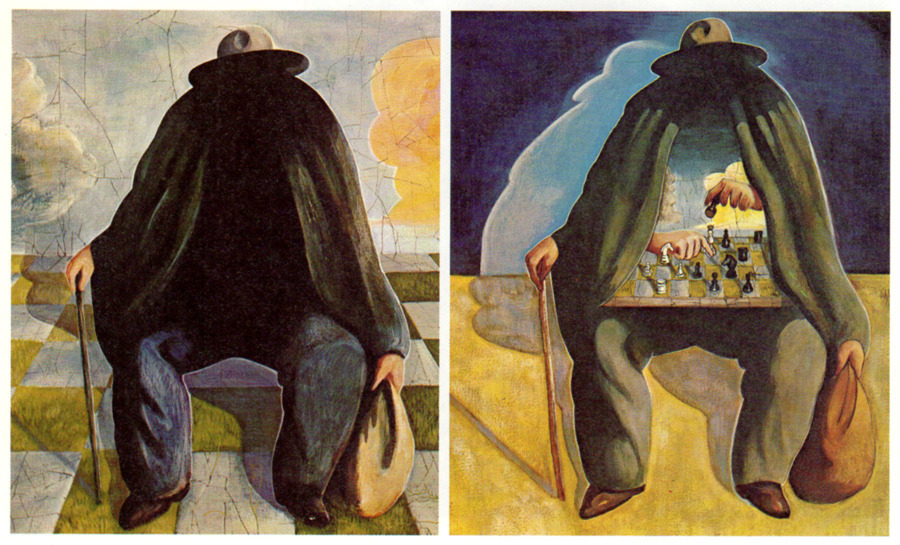(Find me at 50 Watts Books.)
Illustrations by Karl Nicholason for CRM textbooks in the late 60s and early 70s

From Developmental Psychology Today, 1971
Figure 20.8: "The adolescent may show a calm exterior, which often hides a raging inner turmoil."
Karl Nicholason, a key illustrator for Communications Research Machines (CRM) textbooks in the late 60s and early 70s, recently got in touch. Over the years I've posted many wild illustrations—including Karl's—from these books (see the series). Karl sent me a bunch of scans of his work, and I then scanned more from my own collection. I provided publication details whenever possible.
Bio from the publisher's page for Ptimothy Ptarmigan, a recent book illustrated by Nicholason:
Karl Nicholason is a native Californian who has lived in Colorado on and off (here again, gone again) since 1960, including a stint as a student at The Art Institute of Colorado. He holds numerous awards for his illustrations including the Athena award for best four-color illustration, awards from the American Institute of Graphic Arts, the Saint Louis Art Directors Club (gold medal), the Philadelphia Art Directors Club (silver medal), and the Society of Publication Designers (merit award). One of his paintings resides in the Permanent Collection of Fine Art at the Western Colorado Center for the Arts.
In our back-and-forth, Karl gave a couple insights into how these books were received at the time (something I've long wondered about). He mentioned "Psych Today and CRM books were called the MAD magazine of textbooks and I was called 'Dial-A-Style' back then...so what." (Indeed.) Also: "Time and/or Newsweek did at least one article on us in, I don't remember, 69-70-71. They were pretty jealous of our working conditions and didn't hide it."
Stay tuned for another post on Phil Kirkland's CRM work.

From Society Today, 1971
From Chapter 22: Religion as a social institution

From Abnormal Psychology Today, 1972 (def. also used in another CRM textbook)
Fig. 5.8: One important aim of existential psychotherapy is to help the person assume responsibility for his own actions, because only through accepting responsibility can the client create meaning in his own life. Different existential therapists, however, may use totally different approaches; the label "existential" represents a viewpoint, not a method. Frankl, for example, has developed the techniques of paradoxical intention and de-reflection, which he uses to help a client deal with neurotic disturbances. These methods, which are described in the chapter, help the individual to "control his own chess board" rather than being one of the pawns.

From Psychology Today, 1970
Illustrates the section "Agression Directed Inward"

From Developmental Psychology Today, 1971
"Figure 23.9: The revolutionary versus the patient."

From Abnormal Psychology Today, 1972
section on personality disorders: "explosive" (top), "antisocial" (right), "obsessive-compulsive" (bottom), "explosive" (left)

From Abnormal Psychology Today, 1972
section on personality disorders: "paranoid" (top), "schizoid" (right), "cyclothymic" (bottom), "asthenic" (left)

From Abnormal Psychology Today, 1972
section on personality disorders: "hysterical" (left), "cyclothymic" (right)

From Psychology Today, 1970
Illustrates the section on homosexuality

From Society Today, 1971
From Chapter 5: The demographic basis of society

From Society Today, 1971
From Chapter 12: The world of work

From Society Today, 1971
From Chapter 28: Knowledge and social structure

From Psychology Today, 1970
Illustrates the section on personality disorders

Fig 26.8: "Sir Thomas More defied the British Parliament's Act of Supremacy, which had given control of the Church of England to King Henry VIII. His disobedience, expressed in this impassioned statement, cost him his life. Obedience to rules, laws, and commands are crucially important for the welfare of a social order, and disobedience to them may mean an overturn of that order—as in the American revolution." [From Robert Bolt, A Man for All Seasons]

Fig 24.15: "The Bennington study by Newcomb revealed that these college students made a transition from identification with their families and homes to identification with the values they learned at college, and that their identification with the college reference group lasted long after they had graduated."

"In Goffman's terms, this character is an actor; the people he will meet during the evening constitute his audience." (Quote from Hubert Selby, Jr., Last Exit to Brooklyn)"




From Biology Today

From Psychology Today, 1970
Illustrating (I think) the section titled "Organic Psychosis"

Illustrating "sequential causative factors" in psychopathology

From Abnormal Psychology Today, 1972
Illustrating section on low reliability of psychiatric diagnoses

From Psychology Today, 1970
Illustrating the section on psychoses

From Psychology Today, 1970
"Figure 13.1: Our sensory systems do not transmit copies of the external world to an audience in the brain but rather perform complex encodings of information that are somehow interpreted in higher centers."

From Society Today, 1971
From Chapter 10: Youth and society

From Society Today, 1971
From Chapter 3: Biology and society

From Society Today, 1971
From Chapter 2: Basics concepts: the society game

From Society Today, 1971
From Chapter 11: Formal organizations
***
And some non-textbook illustrations from the same time period:

silver medal for illustration at the Philadelphia Art Director's show in 1976

"Film critics, like art critics, tend to reduce big visual ideas to little words. Leaning the other way, we sent artist Karl Nicholason to the Los Angeles press review of The Yellow Submarine. This is his review."


























